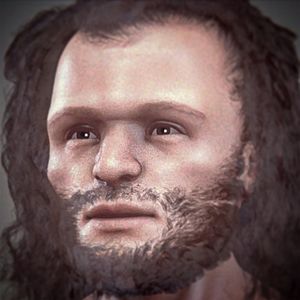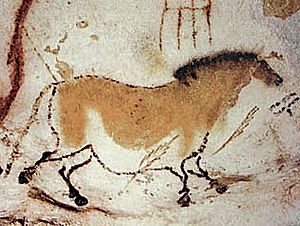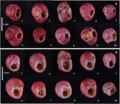Cro-Magnon facts for kids
The Cro-Magnon were early modern humans, also known as early Homo sapiens. They lived in Europe during a time called the Upper Palaeolithic period. Some scientists use the name "European early modern humans" to describe them.
The oldest Cro-Magnon remains found are between 35,000 and 45,000 years old. The very oldest, from 43,000 to 45,000 years ago, were found in Italy and Britain. Other discoveries show that Cro-Magnons also reached the Russian Arctic about 40,000 years ago.
Cro-Magnons had strong, solid bodies with powerful muscles. Unlike Neanderthals, who had sloped foreheads, Cro-Magnons had straight foreheads, much like people today. Their faces were short and wide, and they had a large chin. Their brains were even a little bigger than the average human brain today.
Contents
What's in a Name?
The name "Cro-Magnon" was first used by Louis Lartet. He found the first Cro-Magnon skull in southwestern France in 1868. He named the place where he found it Abri de Cro-Magnon.
Abri means "rock shelter" in French. Cro means "hole" in the Occitan language. "Magnon" was the name of the person who owned the land. So, "Cro-Magnon" basically means "rock shelter in a hole on Magnon's land."
Because the name comes from a specific place, scientists now often use the term "European early modern humans" instead. This helps to describe all early modern humans in Europe, not just those from one spot. In the scientific system for classifying living things, "Cro-Magnon" is not an official scientific name.
Cro-Magnon Life
Their Bodies
Cro-Magnon bodies were shaped very much like human bodies are today. They had the same organs and body parts that allow modern humans to speak. This means Cro-Magnons could also speak and communicate with each other.
Their Culture and Tools
Cro-Magnons were different from Neanderthals because they did more than just survive. They created amazing art, made detailed tools, and wore jewelry. They had a rich culture. For example, Cro-Magnons:
- Carefully shaped bone, antler points, and flint to make their weapons work much better.
- Created small statues, including figures known as Venus figurines.
- Painted incredible cave paintings on cave walls.
- Used bones, shells, and animal teeth to make jewelry.
- Spun and dyed flax fibers to make cords. They used these cords for tools, baskets, or to sew clothing.
Like most early humans, Cro-Magnons mainly hunted large animals for food. They hunted mammoths, cave bears, horses, and reindeer. They used spears, javelins, and spear-throwers to hunt. They also gathered and ate plants.
Cro-Magnons were nomadic or semi-nomadic. This means they did not live in just one place. Instead, they followed the migrations of the animals they hunted. They may have built hunting camps using mammoth bones. Some of these camps have been found in a village in the Ukraine. They also made shelters from rocks, clay, tree branches, and animal fur.
Related pages
Images for kids
-
Potential EEMH musical instruments: bone flute (left), whistle (centre), idiophone (bottom), and bullroarer (top)
-
EEMH tribe in H. G. Wells' The Grisly Folk
See also
 In Spanish: Hombre de Cromañón para niños
In Spanish: Hombre de Cromañón para niños












